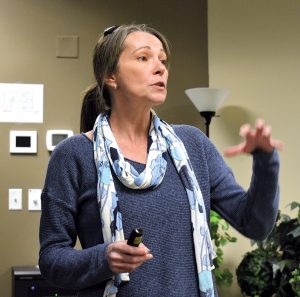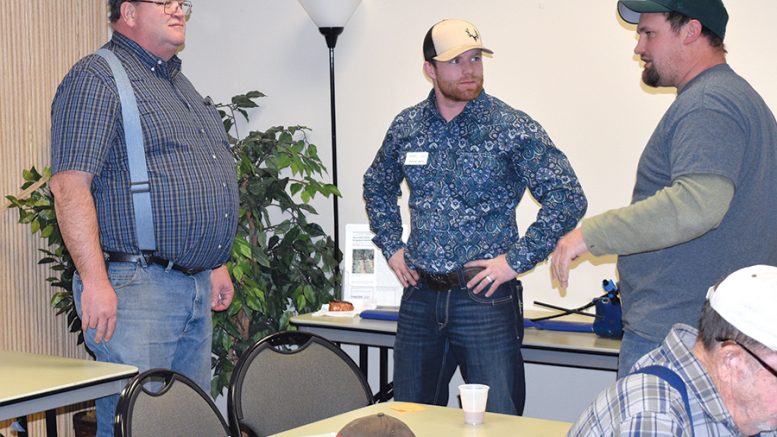Story by Mike Pace, Utah State University Extension Agent
Photos by Dave Alexander, Publisher
From the Food Safety Modernization Act to drip irrigation, and from controlling spray drift in onion production to Iris yellow spot virus research, a wide range of topics were covered at the 2018 Utah Onion Association winter meeting held Feb. 13 in Brigham City, Utah. In addition to hearing the latest updates on all these issues, attendees had a chance to inspect the 2017 onion variety trial results.

Karin Allen, Utah State University Extension food quality and entrepreneurship specialist, explains the many intricacies of the Food Safety Modernization Act.
FSMA
Dr. Karin Allen, USU Extension food quality specialist, shared the latest details of the Food Safety Modernization Act (FSMA) produce safety rules. Allen explained that the produce safety rule encompasses agricultural water quality, biological soil amendments, domesticated and wild animals, worker training and health/hygiene, equipment, tools and building- and sprout-specific regulations.
USU Extension and Utah Department of Agriculture and Food (UDAF) are working together to provide outreach, training and resources. UDAF is currently working on a produce safety website, while USU Extension is putting together food safety resources and helping to conduct trainings for various producers groups in Utah.
“Since food safety is critical to American agriculture and farmers are the first point in helping to maintain a safe food supply, the partnership between UDAF and USU will help Utah farms achieve the national food safety goals,” Allen said.
PSA grower trainings were held in March or April to help producers understand the produce safety rule as farm inspections are set to begin during the 2019 growing season.

Leigh Vaughn, senior produce category manager with Associated Food Stores, tells his audience that locally-sourced produce is very important to consumers.
Purchasing Requirements for Local Produce
Leigh Vaughn, senior produce category manager with Associated Food Stores (AFS), reported that AFS is committed to source as much viable local product as possible. He shared a 2017 Food Marketing Institute report that showed consumers placed “locally grown products” higher on the scale than “freshness” when shopping for produce for their family. Vaughn emphasized that the stores are committed to helping local growers remain profitable.
At the same time, Vaughn explained, AFS now requires all suppliers, regardless of dollar sales, to be food-safe certified. As of yet, AFS has not designated which GAP certification program (Global GAP or Harmonized GAP) food suppliers will have to use if they want to sell produce to Associated Food Stores.
“Gone are the days of pickups and cash payments from the retailer,” he said. “The Food Safety Modernization Act has increased the amount of regulation and paperwork necessary to conduct business in the retail marketplace.”
Controlling Drift in Onion Fields
Dr. Corey Ransom, USU Extension weed specialist, presented information about adjuvants and additives that can be used to help pesticides more effectively control weeds and control drift in onion fields.
“Reading and following the pesticide label is more important than ever with some of the new insecticides and herbicides you are going to be using. These new labels specify the type and size of nozzle you have to use and the spray pressure range in order to prevent spray drift and pesticide movement from offsite,” Ransom explained to his audience.
Ransom showed several videos with different nozzles under various pressures to illustrate his point of what happens to products when they are incorrectly applied and the potential for drift. He reminded the group that the label is the law when spraying pesticides and that labels are constantly changing so it is important to review them prior to each application.
2017 Utah Onion Variety Trial
Mike Pace, USU Extension agent for Box Elder County, reported that the USU Onion Variety Trials were planted in Box Elder County on a drip-irrigated field and in Weber County on a furrow-irrigated field. Thirty-four varieties were planted in the trials on March 17, 2017.
Soon after planting, bulb mites severely reduced plant population stands at the drip irrigation location in Box Elder County. The research team did not replant or treat the plots at this site but left them to see what would happen to the onions throughout the growing season.
Average plant stand counts were significantly lower in the drip-irrigated field (13.1 plants/3 feet) compared to the furrow-irrigated field (29.4 plants/3 feet). Eleven onion varieties had higher yields than the grower variety (798 bags at 50 pounds each) in the furrow-irrigated field in Weber County, with the highest yielding variety averaging 1,029 marketable bags (50 pounds). Five of the onion varieties had higher onion yields than the grower variety (1,976 bags) on drip irrigation in Box Elder County, with the highest one producing 2,191 bags of marketable onions.
[slideshow_deploy id=’1209′]

